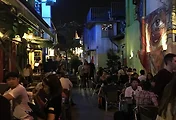ㆍ‘이유식 조리법’의 작은 기적 아프리카 르완다를 가다

르완다 루치로주 기항고에서 한 아이가 몸무게를 점검하기 위해 체중계에 매달려 있다. 월드비전은 코이카(KOICA)와 이 지역의 영양 상태가 좋지 않은 5세 미만의 영유아와 아이들을 키우는 엄마들을 대상으로 지역에서 먹거리 개선 방식을 찾고 있다. 월드비전 제공
걱정스러운 표정으로 세살배기 아들 케빈을 안아 올린 엄마 클레멘타인(28)은 저울의 눈금을 확인하고 나서야 미소를 띠었다. 눈금이 가리킨 숫자는 16. 르완다에서 남자아이가 정상적인 성장을 하면 36개월에 몸무게는 최소 11㎏에서 18㎏은 돼야 한다. 케빈의 두 달 전 몸무게는 12㎏이었다.
“다른 아이들보다 팔뚝도 얇았어요. 간신히 정상수치를 넘긴 수준이라 우리 아이가 제대로 자라고 있는 것인지 걱정되더라고요.”
저울에 매달린 채 엄마를 찾으며 울음을 그치지 않던 산드라도 두 달 전 몸무게가 10㎏이었다. 30개월 여자아이 성장 기준치를 간신히 넘겼다. 하지만 이날 다시 재 본 몸무게는 14㎏으로 늘었다.
내 아이 입으로 들어가는 것이 아까운 부모가 있을까. 무엇이든 잘 먹고, 잘 자라주길 바라는 마음은 세계 어느 나라 부모나 똑같다. 가난과 굶주림이 일상이 된 대륙, 아프리카도 다르지 않다.
르완다 서쪽에 위치한 루치로주(Rutsiro District)는 수도 키갈리에서 꼬박 3시간을 자동차로 달려야 닿는 시골 지역이다. 다섯 살이 안된 영·유아의 60.3%가 만성적인 영양실조를 겪는 곳이기도 하다. 전국에서 세번째로 높은 수치다. 시내에서 한참 떨어진 지역인 무슈바티와 기항고는 상황이 더 좋지 않았다. 도시화가 덜 된 탓에 물자 이동이 쉽지 않아 먹거리도 풍부하지 못하다. 아직 전기가 들어오지 않은 집들도 있다.

월드비전은 지난해 무슈바티의 37개 마을, 기항고의 34개 마을에 사는 세 살 이하 아이들의 몸무게와 나이를 전수조사했다. 4610명 중 2012명이 영양실조 상태였다. 1㎏ 안팎의 가벼운 체중 미달 아이들도 포함한 숫자지만 생각보다 훨씬 영양상태가 좋지 않았다. 5세 이하의 영양실조는 면역성 약화로 이어져 한 번 아프면 회복이 어려워질 수 있다. 신체뿐 아니라 인지발달과 지적성장에 영향을 미칠 수도 있기 때문에 간과해선 안된다.
지난 1월25일 찾은 기항고에서 케빈과 산드라를 만났다. 동네의 ‘큰엄마’로 불리는 조넷(38)의 집에 마을 아이들과 함께 모여 있었다. 마당에서 아이들이 놀기 시작하자 엄마들은 저마다 집에서 가지고 온 식재료를 가방에서 꺼냈다. 감자와 차요테, 시금치, 방울토마토 등 종류도 양도 제각각이다.
조넷이 큰 통에 물을 받고 비누도 꺼내왔다. 엄마들은 손가락 사이, 손톱 밑, 팔꿈치까지 깨끗이 씻었다. 10여명의 엄마들이 모은 재료들을 씻고 껍질을 벗겨냈다. 그런 다음 큰 솥에 한데 넣고 식용유를 조금 두른 뒤 삶기 시작했다. 30분쯤 지나 재료들이 푹 익자 소금 간을 했다. 그리고 주걱으로 으깨기 시작했다. 우리나라에서도 이유식으로 많이 만드는 퓌레다.

“이렇게 하면 아이들이 먹기 싫어하는 것도 골라낼 수가 없으니 다 먹을 수밖에 없어요. 르완다에서 전통적으로 아이에게 밥을 먹이는 방식은 아니에요. 동네 한 엄마가 이런 식으로 이유식을 만들었는데 카사바나 쌀밥 등을 따로 먹는 아이보다 발육이 좋더라고요. 그래서 다 같이 따라 하게 된 거예요.” 열심히 퓌레를 만들던 조넷이 설명했다.
음식이 완성되자 아이들은 짭조름하고 고소한 맛의 채소 범벅을 맛있게 받아먹었다. 클레멘타인은 집에선 밥을 잘 먹지 않았던 아들이 한 그릇을 비우는 것을 보며 흐뭇해했다. “케빈은 여덟 살 형하고 같이 밥을 먹었어요. 차려만 주고 일하러 나갔기 때문에 먹는 것을 지켜보지 못했어요. 나중에 큰아이가 쌀을 싫어하는 케빈은 먹지 않았다고 하더라고요. 이제 콩과 감자, 쌀을 같이 삶아 이렇게 으깨주니 살이 부쩍 올랐어요.”
르완다의 일반 가정 밥상은 밥에 반찬을 곁들여 먹는 우리와 비슷하다. 카사바(Cassava) 가루로 쫀득쫀득한 푸푸(foufou)를 만들거나 쌀밥을 지어서 콩요리 하리콧(haricot), 어른 손가락만 한 굵기의 민물고기 삼바자(정어리과 생선) 튀김, 소고기 카문델레(kamundele), 염소고기 냐마초마 등을 함께 먹는다. 바나네플랜탕(bananeplantain)을 찌거나 튀겨서 먹기도 한다. 시골 마을에선 각자 밭에서 키운 옥수수를 찌기도 하고, 감자를 튀겨 먹는다.

르완다 루치로주 기항고에서 한 엄마가 아이들의 점심을 위해 싸온 감자를 통에 넣고 있다(위 사진). 자원봉사자들이 아이의 발육상태를 점검하기 위해 팔뚝 굵기를 재고 있다. 김보미 기자
내륙국인 르완다는 바다가 없어 먹거리가 풍부하지는 않지만 메마른 땅은 아니다. 염소나 소를 키우는 집들도 많다. 그러나 여전히 굶는 아이들이 있고, 한 마을에서 같은 음식을 먹어도 아이마다 영양상태의 편차가 크다. 엄마가 어떻게 밥을 지어 어떤 방식으로 먹이는가에 따라 다르기 때문이다. 특히 어른들처럼 밥을 먹지 못하는 유아들의 이유식은 그 방법의 차이가 아이들의 성장과 직결돼 있다.
월드비전이 코이카(KOICA)와 지난해부터 5세 미만 어린이를 키우는 엄마들을 대상으로 보건영양 개선사업을 시작한 것도 이 때문이다. ‘PDHearth’(자발적 영양보건행동을 유도하는 영양중재법)로 불리는 이 사업은 지역에서 스스로 아이들의 영양 문제를 해결하도록 하는 것이 목표다. 긍정적인 일탈(Positive Deviance)과 아궁이(Hearth)를 합친 말로 나쁜 식습관은 고치고 지역에서 구할 수 있는 식재료와 누구나 할 수 있는 요리법을 찾아 아이들의 먹거리를 개선해보자는 것이다.
특히 루치로와 같이 길 사정이 좋지 않은 지역은 외부에서 먹거리를 들여오기 쉽지 않다. 지원에 의존하는 것도 장기적인 해결책이 되지 못한다. 최근 공적개발원조(ODA)에서 인류학적 접근이 이뤄지는 것도 같은 맥락이다. 외부인의 관점으로 사회 구조와 경제를 바라보지 않고 내부의 시선으로 필요한 것과 해야 할 것들을 찾아 지역에 맞는 방식을 찾는 것이다.
그렇게 기항고에서 찾아낸 방법이 채소와 다양한 먹거리를 한데 섞어 이유식을 만들어 먹이는 것이다. 또 마을에서 자원봉사자 3명이 나서 두 달간 먹는 방식을 바꾼 아이들을 꾸준히 지켜봤다. 수시로 키와 몸무게, 팔뚝 굵기 등 아이들의 상태를 확인하고 엄마들의 평소 살림 습관, 영·유아를 돌볼 때 알아둬야 할 정보 등을 공유했다.
또 정기적으로 모여서 함께 식사하는 자리를 마련했다. 이때 엄마들에게 집에 있는 식자재나 물, 조리기구, 땔감 등 무엇이든 가져오도록 했다. 지원을 받는 것이 아니라 스스로 문제를 고쳐나가고 있다는 인식을 심어주고 자존감도 높이기 위해서다. 보통 두 달이면 아이의 상태는 정상으로 회복되지만 대부분은 두 달가량 더 참가한다. 엄마들의 행동을 변화시키는 시간도 필요하기 때문이다.

전지환 한국 월드비전 보건영양개선사업담당자는 “영양실조 해결은 지역주민들이 열쇠를 가지고 있다”며 “가난하지만 아이들이 잘 먹고 잘 크는 집이 있다. 지역 내에서 구할 수 있는 재료와 할 수 있는 방식으로 지속적으로 실천할 수 있는 방법을 찾아야 한다”고 말했다.
외부에서 들여온 식자재가 아닌 그 지역의 물자, 그리고 경험을 발견하는 것이 핵심이다. 전지환 담당자는 “엄마들이 손을 씻는 것부터 시작해 위생관념을 가지고 방법을 공유하는 것도 중요하다. 엄마가 위생관념이 있어야 아이들도 이에 대한 인식과 학습이 가능하다. 르완다에서 육아는 엄마의 역할이 절대적”이라고 덧붙였다.
Not eating ‘More’ but eating ‘Well’
I’m no longer crying on count of malnutrition
By Kim Bo-mi
Posted on : 2016-04-19 14:12
ㆍA miracle of ‘baby food recipe’ Visit of Rwanda in Africa
Clementine (28), mother of a 3-year-old baby named Kevin, lift her son in arms with a troubled look. However, she smiled after checking graduation of a scale because it pointed number 16. In Rwanda, a 36-month-old boy’s weight is generally marked between 11kg and 18kg. But Kevin weighted only 12kg in a couple months ago.
“He had leaner arm than other boys. His weight was just above the normal figure, so I worried a lot about his development and growth.”
Sandra, who cried a lot and looked for her mother while hanging herself on a scale, weighted only 10kg. She barely passed over the normal weight of 30-month-old girl, too. However, she is currently weighted as 14kg.
There would be no parents who begrudged the food for their children. All parents in the world, regardless of their nationality, want their child to eat and grow well. There is no different for Africa, the continent suffers from poverty and hunger for each day.
Rutsiro District is located in west Rwanda. The district is 3 hours away from capital city, Kigali. The district holds third highest rate, 60.3%, on chronic malnutrition of children under age 5. Remote regions like Mushubati and Gihango have a worse condition. Those places do not have enough foods since they have the poor accessibility of supplies because they are not fully urbanized. In those areas, even some houses have no access of electricity.
Last year, World Vision conducted complete enumeration to monitor the weight and age of children, under age 3, from 37 villages of Mushubati and 34 villages of Gihango. It resulted that 2012 children, out of 4610, were in the state of malnutrition. The result included the children who are slightly underweight about a kg or less, but still the resulted nutrition status of children is considered as worse than the expectation. If the children under age 5 engage in Malnutrition, their immune system would be weakened then recovering from sickness or diseases would be more difficult. Furthermore, we must not ignore that malnutrition could affect not only fir the physical growth but also for the cognitive and intellectual development.
On 25th day of January, I met Kevin and Sandra in Gihango. They were gathered together with other children, in the house of Jonnet(38) who is called as ‘Big Mama’ by the villagers. When children began to play with each other in the yard, mothers took out different ingredient they have brought. Each one brought different kind and amount of ingredient such like potatoes, chayote, spinach, tomatoes and etc.
Jonnet filled the water on a big bowl and took the soap out. Then the mothers washed their hand, under their fingernails, and even their elbow clean. A dozen of mothers cleaned and peeled ingredients. After that, they put all the ingredients in a big pot, putting some oil, then boiled them. When all the ingredients were boiled well, they put some salt on it. Then they started to mash them with a paddle. It was puree which is also widely cooked in Korea for baby food.
“In this way, children have no choice but to eat all of them, whether they like or not, because they cannot pick out what they do not want to eat. It is not a traditional way of feeding children. But we learned it from a mother and saw that her child grew better than the children who ate casaba, rice, and other food separately. From then we decided to follow her recipe,” explained Jonnet while making puree.
Once the food was ready, children enjoyed seasoned and mashed vegetables. Clementine rejoiced to see her son eating well. Her child did not eat well at a home. “Kevin have meal with his 8-year-old brother. I had no time to see him eating food because I went work right after preparing the meals. Later, my eldest child told me that Kevin did not eat a meal because he doesn’t like rice. But now, he eats well because I mashed rice and mixed it with potatoes and beans. He put on weight either.”
A common way of serving meal in Rwanda is similar to Korea. They serve foufou made with cassava power or rice together with different side dishes like haricot and Sampaja, Kamundele, and goat Nyamachoma. They also serve steamed or fried bananeplantain. In a rural village, people eat either boiled corn or fried potatoes.
Rwanda is a landlocked country. The country does not have plenty of food with absence of sea but it is not a dried land. Many families raise goats and cows. However, there still are children suffering from hunger. Moreover, there is large deviation among the nutritional status of children even they live in the same village and eat the same food. The status of children depends on the way that mother feeds their child. In particular, development of child is directly related to a recipe of baby food because children do not eat rice, unlike adult.
With this reason, World Vision launched Health& Nutrition Improvement Program targeting the mothers of the children under age 5, partnering with KOICA. The program, called PDHearth, aims to build community’s capability in addressing the nutrition issues among their children. The name is composed of two words, ‘Positive Deviance’ and ‘Hearth’ expecting to improve children’s food through searching ingredients and recipe that anyone can use, and to correct the bad habit of eating.
It is not easy to import foods from other places particularly for the regions having bad road, just like Rutsiro district. Relying on assistance from outside might not be a long-lasting solution for it. This can be understood in the same vein with an application of anthropological approach in ODA. Instead of using outsider’s angle in viewing the social structure and economy, they have to find their needs and things to do through an insider’s angle while using a suitable method for their own village.
Through this, Gihango found their own solution such as making baby food through mixing all vegetables and ingredient. In addition to that, two volunteers came out to observe children who have switched their way of eating. They frequently monitored children’s status through checking height, weight, the thickness of forearms, and etc. Then they also shared each mother’s daily housekeeping practices and information needs in caring young children.
Moreover, they regularly arranged times for everyone to eat together. At this time, they assigned mothers to bring ingredients, water, cooking utensils, firewood or whatever they have. They did this in order to help mothers to be aware of their contribution in addressing problems, and to develop their self-esteem. Commonly, child’s status turns into a normal level just after 2 months, but they usually participate for another two months. It is because the mothers also require time to change their own habits.
Ji-Hwan Jeon, Health& Nutrition improvement Manger of World Vision Korea, said “Community has a key to solving malnutrition. There are children who eat and grow well even they are poor. We have to find the ingredients available in the region, and to think of consistent way of practicing what they can do.”
The core of this program is using available supplies instead of bringing them from the outside, and finding experiences. “It is important to share method and have good hygiene practice including proper hand-washing. It is only possible for children to be aware and to learn about hygiene practice if their mother has good hygiene practices. In Rwanda, each mother has an absolute role in nurturing a child,” added Ji-Hwan Jeon.







